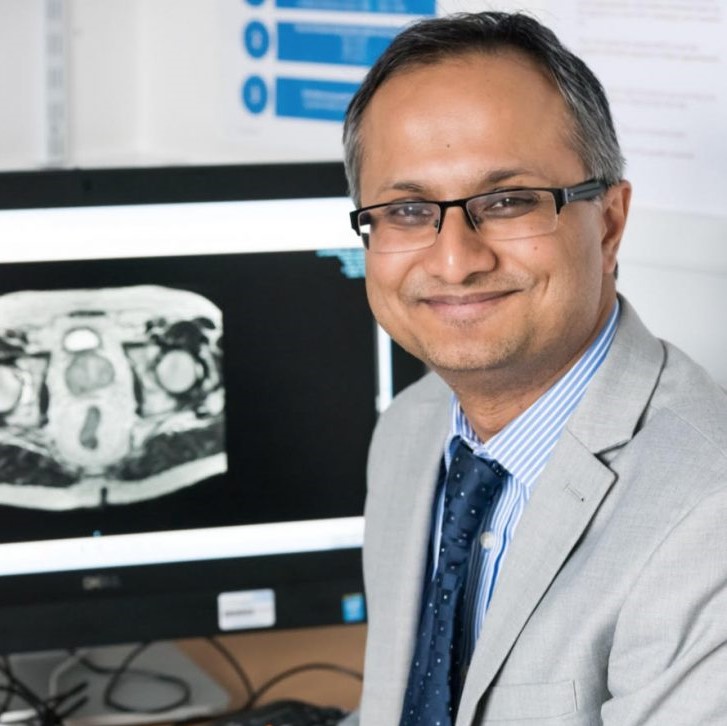Prostate matters is a not for profit organisation committed to providing free information about prostate issues from leading Clinical Authorities.
Home /
What is Prostate Cancer?

Chair in Urology and Consultant Urological Surgeon
Imperial College NHS Trust
Almost all men over 60 will have one or more prostate cancer lesions, but only 3% of those will die of the disease. What is important is to find tumours that are likely to affect the patient’s life and only treat those.
Adenocarcinoma is the type of cancer that develops in gland cells. It is the most common type of cancer found in the prostate gland.
About the Prostate
The prostate is a small gland that secretes much of the liquid portion of semen, the milky fluid that transports sperm through the penis during ejaculation.
The prostate is located just beneath the bladder, where urine is stored, and in front of the rectum. It encircles, like a donut, the first section of the urethra; the tube that carries urine from the bladder out through the penis. During ejaculation, semen passes from the testicles, through the epididymis and then vas deferens. The vas on each side enters the prostate, joins an ejaculatory duct and from there enters the urethra. The bladder neck acts as a valve preventing backward passage of sperm into the bladder, and muscles around the urethra contract so that it is passed out through the penis.
The prostate is made up of three lobes encased in a thin outer covering, or capsule. It is flanked on either side by the seminal vesicles, a pair of pouch-like glands that contribute secretions to the semen. The testicles, in addition to manufacturing sperm, produce testosterone, a male sex hormone that controls prostatic growth and function.
Prostate cancer
Cancer of the prostate is a disease unique to men as only males have a prostate. As the prostate is a ‘gland’ it may develop cancer in a similar way to the glandular tissues of the breast or the thyroid. There are about 48,000 new cases diagnosed per year in the UK, and about 12,000 deaths.
Prostate cancer stage & grade
There are two important factors to consider when dealing with prostate cancer – the ‘stage’ and the ‘grade’. (For more information see “Staging Prostate Cancer – Measuring its Severity.)
The stage refers to how far the cancer has physically spread from its origin;
- it may still be confined to the prostate gland (‘localised or organ-confined’),
- it may have spread beyond the capsule into tissue around the prostate or organs of the pelvis (‘locally advanced’),
- it may have spread outside the pelvis (‘metastatic’) either through the blood stream or lymph glands.
The grade refers to how aggressive the cancer cells appear under the microscope and is usually given a score: more specifically, the ‘Gleason grade’, named after a histopathologist who devised a reliable system for attributing a grade.
The Gleason grade and score is made up of three numbers, such as 3+3=6, 3+4=7, 4+3=7, 4+4=8, 4+5=9 or 5+4=9. Each number refers to the two most common types of cell seen in the biopsy cancer tissue with the most common grade first. The first two numbers or ‘grades’ ranging from 1-5 are added to give the final ‘score’ ranging from 2-10. The higher the total score, the more aggressive the prostate cancer is. In the modern era, scores of 2 to 5 are rarely given as these are now commonly regarded as non-cancerous. The higher the total score, the more likely it is that the prostate cancer may spread outside the prostate. Cancers of very low grade (Gleason number) may not need treatment and can be watched (Active Surveillance) whereas cancers with higher grades are likely to require treatment. Some have advocated re-labelling Gleason 3+3=6 as a benign entity because it is low risk, although this proposition is controversial.
An enhanced type of MRI scan “multiparametric” is now the recommended diagnostic test used to detect disease before biopsy (covered in more detail in subsequent sections). There is emerging evidence that the scan can tell us something about the grade of a tumour.

Prostate matters is a not for profit organisation that is committed to providing free expert advice about prostate issues from leading Clinical Authorities
In memory of Riki
PROSTATE MATTERS
Copyright Disclaimer: We try to acknowledge copyright as appropriate. If we have used something without acknowledging copyright, this is inadvertent. Please let us know by emailing info@prostatematters.co.uk
Site design and technical development by Webtoys | Intelligent Digital Media

